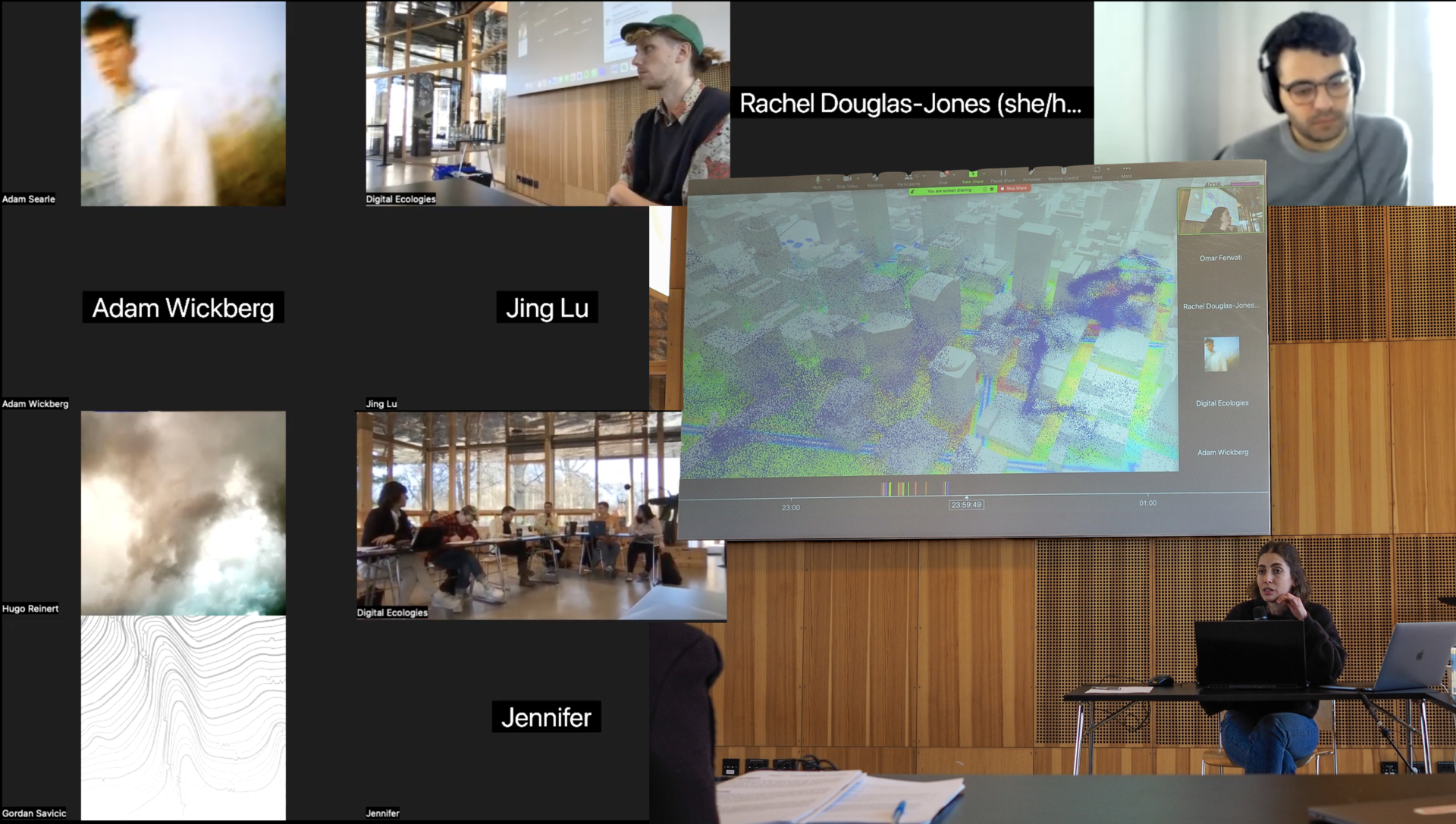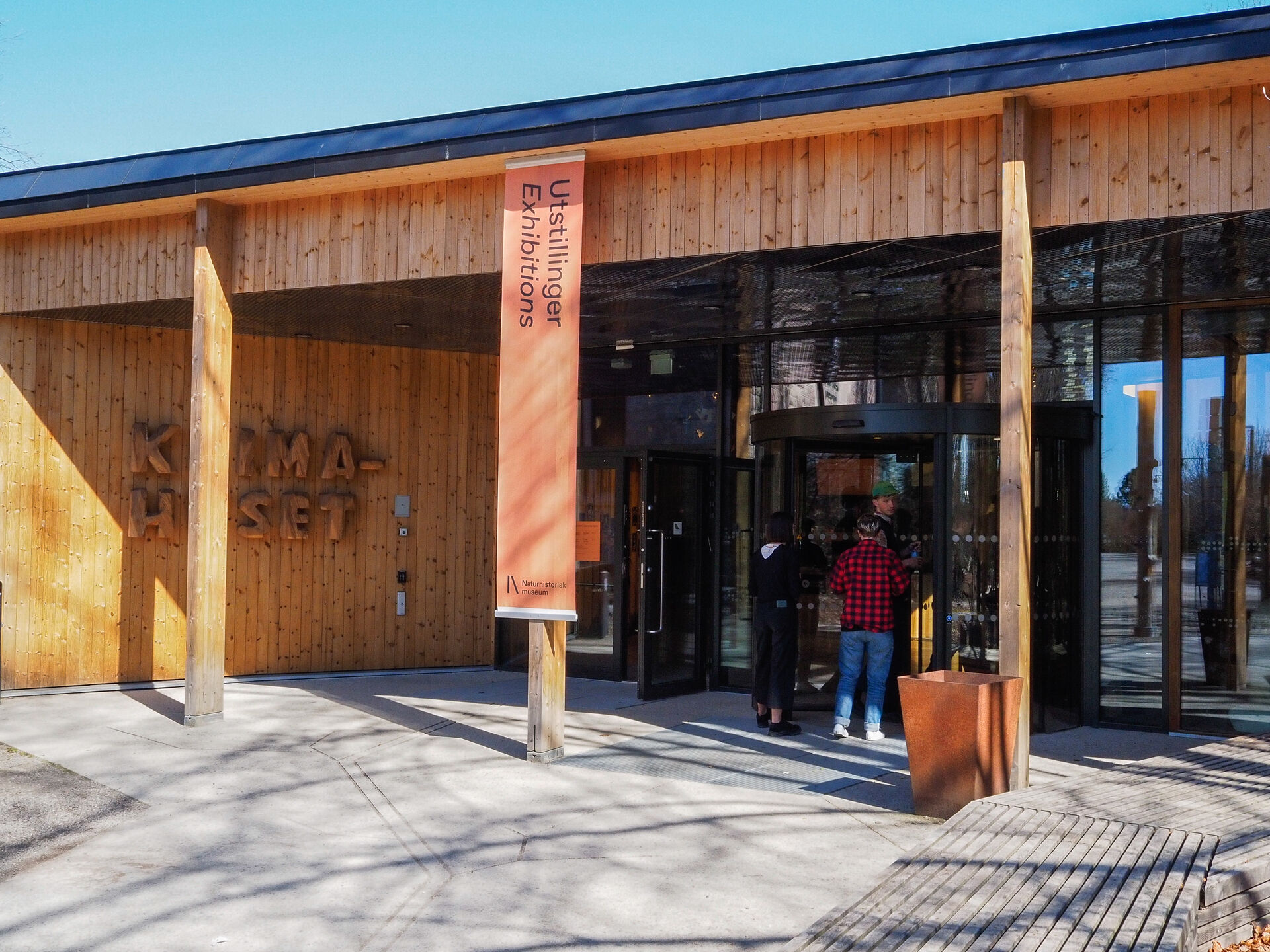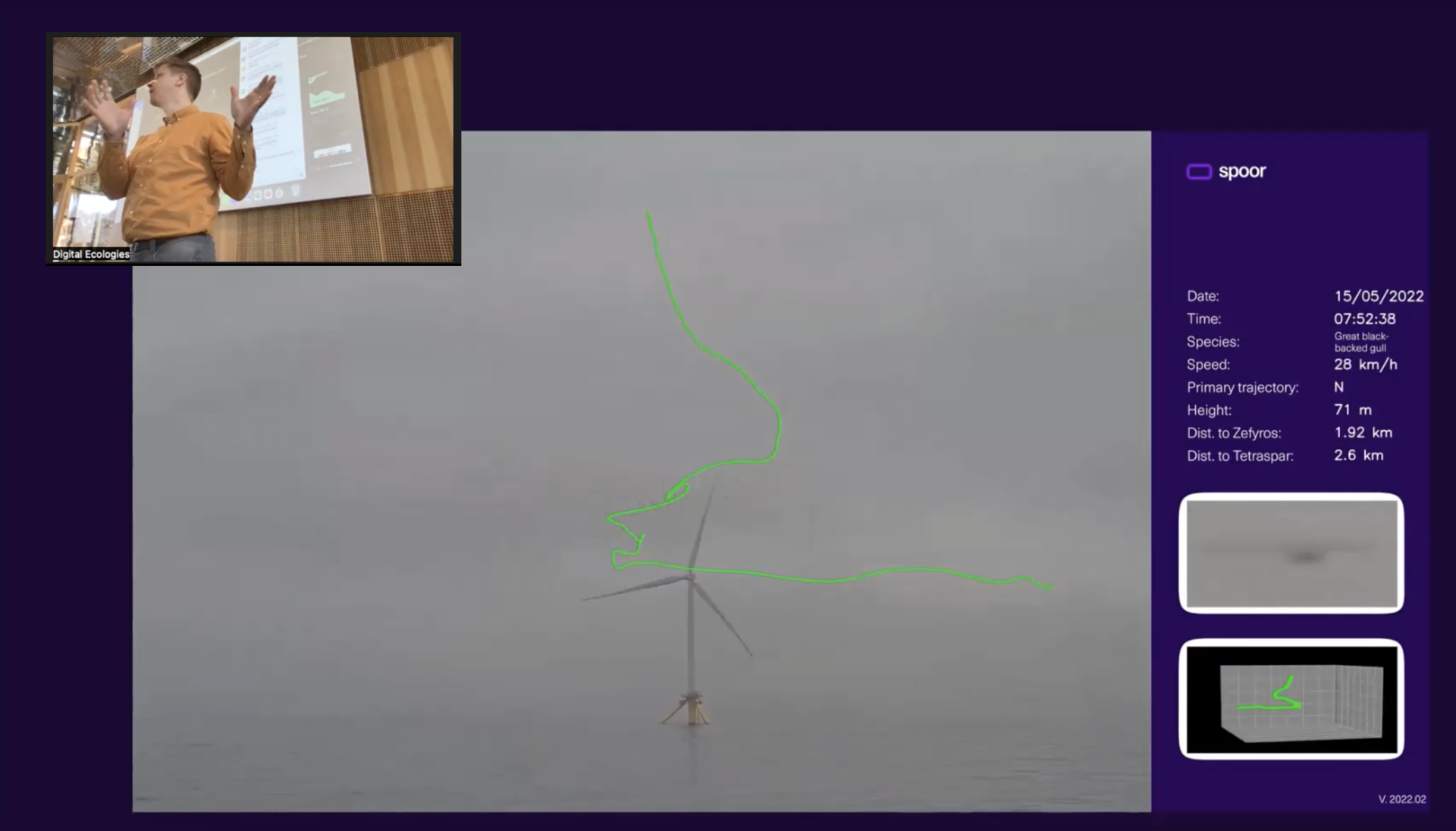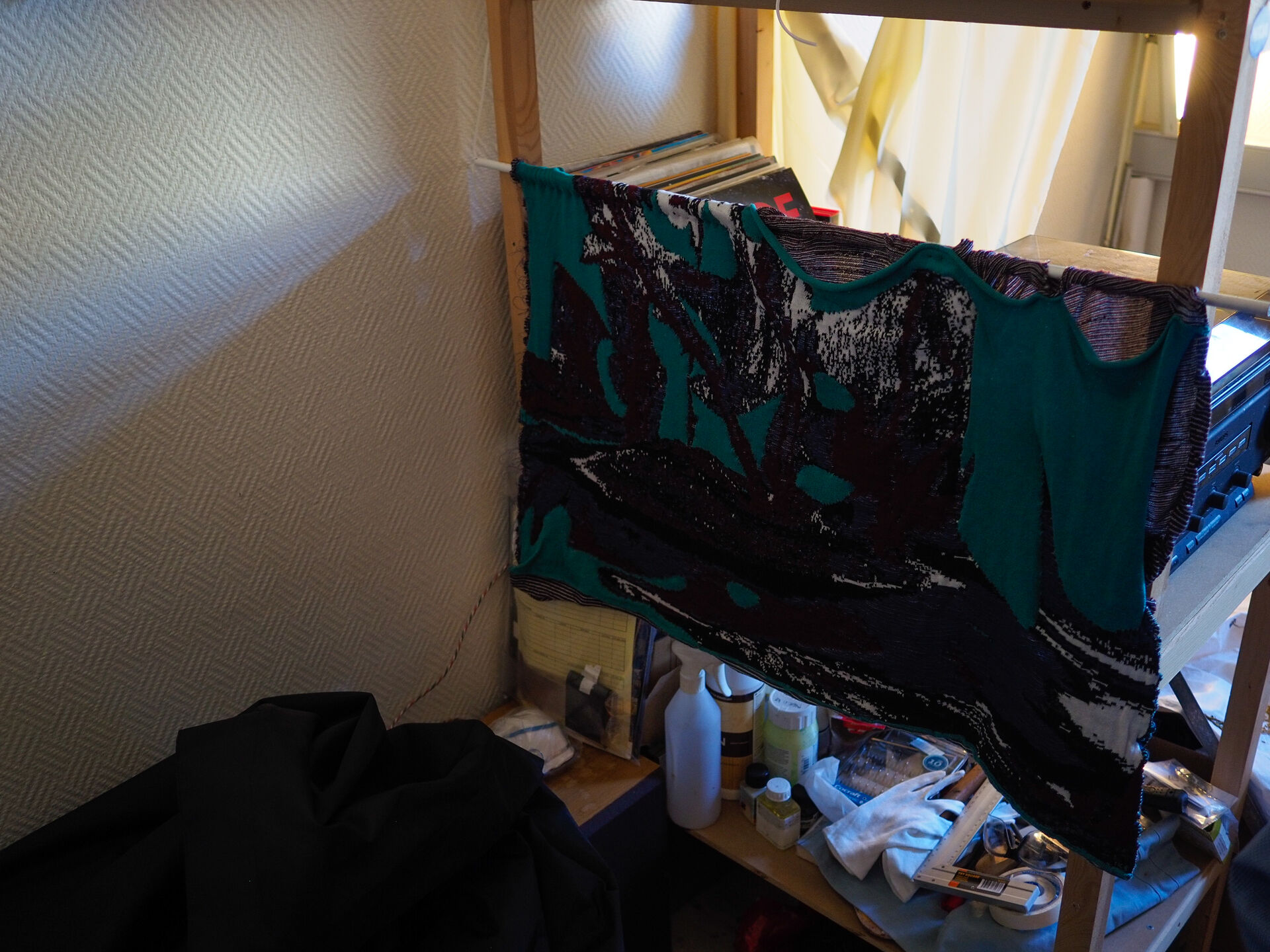The 2023 Bionic Natures x Digital Ecologies workshop took place at the Klimahuset, an environmental exhibition and event space at the Natural History Museum in Oslo on the 21st April. A joint initiative between the Bionic Natures collaboratory at the Oslo School of Environmental Humanities and the Digital Ecologies research group, the workshop brought together participants in-person and online for a day of lively, creative, and critical discussions about natures altered, augmented, represented, and replaced by digital technologies. After the workshop, we spent the weekend engaging with artists participating in the Oslo Open, an annual event where artists open their studios around the city for viewings of completed works and works-in-progress, and frank discussions of their practice. In this blog, we reflect on the workshop and a set of themes that emerged from our conversations and observations, namely the contingency of digital technologies in relation to progressive or regressive environmental politics, and the importance of learning together across academic and artistic disciplines in relation to digital technologies and natures.
Day 1
Panel 1
In the first panel, ‘Towards Forensic Ecologies, we heard from Jasper Humpert, Lola Conte, and Omar Ferwati, researchers with Forensic Architecture. Based at Goldsmiths, University of London, Forensic Architecture is a research agency conducting multi-disciplinary investigations into human rights violations and environmental destruction in collaboration with activists, legal teams, NGOs and media organisations, as well as affected communities and individuals. Omar gave us an overview of the broad scope of the organisation’s work, focusing on four case studies: mapping the role of European governments and arms producers in military operations in Yemen; illegal migrant ‘push backs’ at the Turkey-Greece border; gold mining in the Yanomami territories of the Brazilian Amazon during the Bolsonaro administration; and environmental racism in ‘Death Alley,’ a corridor along the Mississippi river saturated with petrochemical facilities sited on former sugar cane plantations.

By way of these cases, Omar explained the political impetus of Forensic Architecture’s work: to identify, name, and hold accountable those responsible for violence and environmental destruction and to mobilise and propel the testimonies of those affected for different kinds of change. Referencing the multiple spaces in which the organisation operates and disseminates its work, from courtrooms to art galleries, Omar advocated for a need to move beyond the continued amassing of scientific data devoid of narrative, on the one hand, or the display of supposedly critical aesthetic expositions in art spaces or places of culture, on the other, in order to enact this change.
Offering a more detailed account of the methodologies used in Forensic Architecture’s investigations, Lola brought our attention to a fifth recent investigation - the disproportionate and harmful deployment of tear gas by the Portland police force during the Black Lives Matter protests in Portland, Oregon, in June 2020. Focusing on one specific day, known informally as ‘tear gas Tuesday’ for the particularly egregious volumes of gas deployed, Lola illustrated the process of gathering videographic evidence, technical specifications for different munitions, and creating a 3D fluid dynamic simulation in which the concentrations and spread of gases emanating from ‘emission points’ could be modelled and made visible. The investigation found instances where atmospheric concentrations of tear gas were more than 1000 times greater than US federal agencies’ thresholds of immediate danger, with serious consequences for public health and ecological livability as the pollutants spread to riverine ecosystems beyond the city. Lola highlighted the potential of such an approach to critique impunity and lack of oversight in the Portland Police Bureau, and to evidence and visualise otherwise largely invisible forms of violence in support of abolition and legal reform.


In conclusion, Jasper highlighted a series of practical and conceptual contact zones in which the approaches of Forensic Architecture and the Bionic Natures and Digital Ecologies groups might overlap and come together in mutually beneficial ways. Via a discussion of the works of Steven Shapin, Simon Schaffer, and Sheila Jasanoff, Jasper observed the progressive potentials of a ‘digital salon’ for assembling, staging, and mobilising knowledges in ways that are more accessible and democratic than those historically, or even currently, in use. In particular, he drew attention to digital spaces as ones where victims of different kinds of violence may assemble their accounts and knowledges, and where nonhuman perspectives might also be foregrounded, in the pursuit of accountability, justice, and reform.
Panel 2

After briefly taking in the bright spring sun outside the Klimahuset over lunch, we reassembled for the second session of the day, in which we were presented with a triptych of different practical, critical, and creative engagements with environmental data in oceanic and Arctic environments.

In the first presentation, we heard from Søren Enghoff, head of regulatory affairs and impact at Spoor, a Norway-based company developing AI-based solutions to reducing bird-related risks from wind farms. Søren presented a fascinating example of an effort to reconcile environmental and economic concerns amidst growing pressures on marine space from multiple interests, setting, perhaps inadvertently, the stage for later discussions of the ‘Blue Economy’. This was summarised superbly in a map of the Danish seaspace, where 30% has been earmarked for wind energy and 30% for marine protected areas, all the while having to accommodate a range of other uses, from fishing to shipping and other offshore industries. In this context, as Søren framed it, there is an urgent priority of “enabling nature and industry to co-exist.” By mounting cameras on wind turbines, and analysing the footage using computer vision software, Spoor aims to track and quantify the interactions between birds and wind turbines, using this information to inform environmental risk assessments as well as to dynamically modulate the operation of the turbines themselves to prevent risks to birds. Søren illustrated how this works in practice with a video, in which the Spoor AI software identifies a great black-backed gull in the vicinity of a wind turbine and tracks it in three-dimensional space. There was an audible intake of breath amongst workshop participants as the bird appeared to near the rotating blades of the turbine, but, fortunately, this was an illusion of the flattened visual perspective in the video. One of the things we found most striking about Søren’s presentation was the interplay of human and computational cognition and agency evident in the attempts to transfer Spoor’s ornithologist’s knowledge into the effective operation of the AI, which the ornithologist described as: “we are essentially trying to copy my brain, with a lifetime of ecologist training, into the AI.”

The theme of interactions between different kinds of logics, spatialities, and worlds was at the forefront of the second presentation by historian of media and environment, Adam Wickberg. Adam discussed the sociotechnical imaginary mobilised in and through digital ocean twins - described as “a coherent, high-resolution, multi-dimensional, multi-variable, and near-real-time representation of the ocean that integrates different new data sources with modelling, AI, and high-performance computing [...] to supply citizens and decision makers with up-to-date science backed knowledge to protect marine environments.” Adam illustrated how these digital twins are fundamentally entangled with an emerging vision of the Blue Economy in which sustainable exploitation and protection of the oceans can be balanced through combinations of sophisticated digital technologies - familiar from Søren’s presentation. Acknowledging the new insights and novel, potentially more effective, forms of governance digital twins might enable, Adam nevertheless highlighted that the current trajectory of the ‘Blue Acceleration’ - the intensification of multiple damaging human pressures on the ocean - has in fact developed in synchrony with the emergence of more and better sensing technologies and more and better data about the oceans. This, he suggested, indicates that there is much to critique in visions (such as that visualised in the EU graphic below) of flourishing ocean ecosystems and economies enabled in a straightforward manner by the development of digital ocean twins.


How, then, might environmental data be mobilised in alternative ways in pursuit of new ‘prototypes for eco-social renewal’? This was the concern of architectural designer and researcher Andra Pop-Jurj’s talk, in which she presented her collaborative project ‘Monsters and Ghosts of the Far North.’ Aimed at exploring “what we can do with environmental data in a 3D digital space,” the project is a multi-player interactive installation, with aspects of a game, taking place in a 3D landscape created by overlaying different kinds of information about Arctic environments, animal movement and ecology, resource extraction, and geopolitical conflict using a gaming engine. The installation can be navigated from the perspective of a number of different nonhuman characters, including a caribou, an arctic tern, a methanogenic microbe, and an arctic cod, who have to navigate and get by in an environment characterised by increasing change and intensifying human activities; from fishing to petrochemical extraction. The project playfully and speculatively develops an alternative cartography of the Arctic that departs from those of colonial pasts and datafied presents which foreground specific human perspectives and interests, and asks what it might be like to experience rapidly transforming northern spaces from the perspectives of the installation’s nonhuman cast.

Panel 3
Bringing an ethnographic sensibility to another fascinating case of changing human-animal-technology-environment relations in the North, Marianne Lien transported us to the Sámi reindeer herding assemblages around the Varanger peninsula of Finnmark, Norway, in the first presentation of the final panel. We learned of the ‘speeding up’ of reindeer herding practices in the 1960s with the introduction of snowmobiles and all-terrain vehicles, which replaced older methods of walking and skiing. The loud sound of these vehicles causes the reindeer to move faster across the landscape and, to summarise, they have also increased costs (from fuel), impacts on the landscape, stress levels of the reindeer, and safety concerns for herders moving on fast vehicles across rough terrain. Recently, herders have enthusiastically hailed a ‘revolution’ in reindeer husbandry, facilitated by the affordances of newly available drones, which are seen to facilitate new ways of travelling, engaging with, and visualising the landscape and the movements of reindeer within it. Marianne explored the implications of these drones and other digital technologies, from GPS collars to online reindeer data platforms, for contemporary reindeer husbandry and relations between Sámi people and the Norwegian state. Whilst these technologies underpin new ways of doing, knowing, and relating, they also facilitate the extension of older ones in interesting ways. Marianne concluded with an amusing vignette in which she heard the barking of a dog but could not locate its source: it was coming from a drone, to which a speaker had been attached so that it might emulate the longstanding role dogs have had in herding practices.
Bridging equally deftly between the old and the new, historian of climate science Emil Henrik Flatø explored the epistemic opportunities afforded by counter-cultural traditions in historical climate science. As Emil described, climate science is commonly understood as synonymous with traditions of earth observation, global climate modelling, and the co-production of evidence of anthropogenic climate change. But there are other traditions in the history of climate science, affording other epistemic opportunities. Chiming with the digital twin focus of earlier presentations, Emil explored questions of how the virtual environments of different climate models relate to the more elemental environments of the atmosphere with which they contend, in the context of the tradition of ‘weather and climate modification’ - now generally termed geoengineering - in the 1960s American West. This was a time of eager experimentation, with weather modification seeming to offer a plethora of opportunities, from the economic to the militaristic. In particular, Emil identified the computer as an emerging laboratory in which scientists imagined they could explore how these weather modification technologies might work atmospherically, before or even in place of highly interventionist and costly field experimentation - a legacy which has permeated into contemporary geoengineering research. In sum, Emil suggested that an engagement with the ways in which weather modifiers were engaging with the atmosphere might allow us to fruitfully think of aerial ecologies more like land ecologies, as spaces inhabited, interacted with, and cultivated by humans in different ways.

In the final presentation of the workshop, David Ribes, leader of the Data Ecologies Lab at the University of Washington, sought to explore the ‘sedimentary legacies’ that older data, infrastructures, and modes of instrumentation have on the ways ecological science is conducted today. Honing in on the study of soil from the 1940s to the present in the context of long-term ecological research networks, David described a desired transition from a ‘pure nature’ or biogeophysical to a socio-ecological model of soil science and the data and instrumentation struggles faced in this transition. In short, it has been challenging and costly to incorporate anthropogenic variables into decades-old infrastructures geared towards the collection of biogeophysical data only and this transition has been met with institutional resistance. His message to the socio-ecologists involved in this fraught transition: you will likely be behind for many years, even decades, and won’t be taken seriously by other long-term ecological researchers until you are able to get funding, accumulate research infrastructures, and carry out this work for decades - the path is difficult but not hopeless. His message to us assembled in the room: there is value in pulling back from the ‘now hypism’ associated with data, in thinking about data infrastructures and their legacies in the long-term, and in recognising that older ways of instrumenting the world weigh upon the ways in which we analyse the world today.

Across the three panels, speakers offered their unique perspectives on the practical aspects of using digital technologies to encounter and govern diverse ecologies. Discussions held during the workshop and afterwards allowed us to tease out key themes regarding digital entanglement. Specifically, the case studies presented - some of which were actively hopeful, striving to employ digital technologies in service of justice; others, which contained a more sceptical lens to the potentials inscribed in the techno-solutionism of using digital technologies to enhance ecological relations - made abundantly clear that digital technologies are neither an inherent force for progressive environmental politics, nor are they inherently conduits for the severance of humans from so-called “real” ecologies or bound to lead to dystopian regimes of environmental surveillance. More precisely, their social and political impacts emerge from the historical and cultural contexts within which they are embedded. The result of recognising this, for us, only reifies the need for more empirical and critical research into how diverse digital technologies are used in practice, and with what pros and cons - an argument we have set out at length and in more depth elsewhere.
Day 2 and 3
On the second day of the workshop, we held a group tour of Oslo Open, visiting bionic natures x digital ecologies related exhibits, curated by Noemi Duroux. “Oslo Open is an independent artist-run non-profit organization that was established in the year 2000 by artists and a number of local and national art institutions.”1 Visitors are able to freely wander into artists’ studios around the city for one weekend in April, chatting openly and candidly with the artists about their practice.
Ingrid Bjørnaali
We began with a visit to the studio of Ingrid Bjørnaali, a video and multimedia artist whose works “explore the omnipresence of the digital in our experience of the world as well as the inability of technology to adequately articulate matter’s complexity.”2 Ingrid’s work, which is based on engagements with plants and mushrooms in the area surrounding Oslo, involved visualising swamp ecosystems from the perspectives of various wetland creatures. This took place in virtual reality. On the wall of her studio hung giant printed and stuffed lichens and mosses, created from photographs taken by scientists using microscopic cameras. These ‘pillows’ were hugged by people at raves in an attempt to make the microscopic visceral and encounterable. Ingrid was also experimenting with 3D printed lichen and digital knitting. The knitted fabrics hanging from the wall - based on photographs of old growth Norwegian forests - included a series of glitches, induced by the computational and mechanical complexity of the digital knitting process, which in turn produced beautiful visual patterns that highlight the power of glitches in digital ecologies.


Carolina Vasquez
Next, we visited Colombian artist Carolina Vasquez, whose studio was a short walk away from Ingrid’s at the Oslo National Academy of the Arts. With obvious thematic resonances with Søren’s presentation on day one of the workshop, Carolina’s project - NESTING3 - grapples with the phenomenon of bird strikes in aviation. Again, immersing us into a VR experience, Carolina uses digital technologies to bring humans closer to the experience of nonhumans in a world where human infrastructure is ubiquitous and often deadly. Her vision for a future iteration of the VR experience involves choreographing the bodily movements of participants as they move through her virtual world in such a way as to resemble, without conscious reflection, a bird in motion - moving their heads up and down as if pecking, and their arms as if flying. Such work resonates with the Interdisciplinary Dutch experience design collective, Polymorf, who are also attempting to build multisensory VR experiences.


Isak Wisløff
Next, we visited Isak Wisløff, a multifaceted and interdisciplinary artist who also works pedagogically via his role as an Assistant Professor at the Oslo National Academy of the Arts. Isak’s work combines a range of materials, media, and techniques and is based around three key principles: “Everyone is a composite made of flesh, guts, and bones. Everyone is a consumer of things and culture. Everyone is spiritual in one way or another.”4 His sculptures exude grotesqueness, painted in a way that makes machine become flesh. While discussing his work, Isak expressed a deep interest in the geology of media and technology, keen to render visible the materialities of the digital objects he works with. His work finds a shared materiality between bodies and technologies, and organically resonates with the insights of media scholar Jussi Parikka - whom Isak had not previously encountered. Isak’s sculptures and works embody the idea of bionic natures in myriad ways.


Siri Austeen
Last but not least, we strolled over to Siri Austeen’s studio. Siri’s practice is “concerned with the relationship between sound, place, and reality; how different listening strategies affect our understanding of reality and ourselves as part of a whole.”5 The bookshelves in Siri’s studio were filled with books that resonate with the interests of the bionic natures and digital ecologies communities, with a specific focus on acoustic ecologies and the sounds of nature. Her "practice, which is often based on investigative field recordings, is expressed as sound installations, participant-based projects, performance, radio and public art commissions.” On display in her studio was a listening device that used a car windscreen and other “everyday” objects to amplify sounds recorded at her home. Exhibited as part of the Sonic Propagation project which uses different materials as membranes for emitting sound through transducer technology, the recordings were taken from the Sound House Archive (2020-2022), a personal exploration of grief, sound, and memory. The field recordings feature birds pecking at the feeder near the kitchen window of Siri’s new home, flapping their wings as they fly away, trees rustling in the distance. How we experience change through sound is an oft repeated topic in Siri’s work and ecological structures become an anchor for this. Particularly important are the sounds of landscapes turning from winter into spring and the charm of flourishing new life that comes with it.

Siri’s recording of nonhuman sounds goes back to 2012 with the Sound like Nordland (Lyder som Nordland) project in collaboration with Elin Øyen in which they recorded life around Norway’s Nordland region ranging from humans to orcas to myriad species of birds. Sound files serve as significant contemporary documents that allow us to distil our worlds and navigate them. This rings true for the Sound like Nordland project, for the Sound House Archive project, and the ongoing expansion of this through a new project exploring the history and contemporary situation of mining waste in Sokndal and Dalane regions. Siri’s sound archives and installations become a way to create attention and establish points of connectivity.
From our dérive through Oslo Open, it was clear that themes of ecology and technology are firmly on the agenda of many contemporary artists operating in the Norwegian art space - many of whom are exploring the concerns of the bionic natures and digital ecologies groups in practical and creative ways. Oslo Open provides a wonderfully democratic way of engaging with artists in their own spaces, facilitating open-ended and uncurated reflections from the artists on their practice and creative process. While not always explicitly concerned with the ideas that drive our research groups, it was enlightening to see artists arrive at similar conclusions-in-progress albeit through diverging pathways and epistemologies to our own. This is exactly why we planned to come together as researchers, artists, designers, and practitioners. The scope for cross-disciplinary pollination and collaboration in the fields of bionic natures and digital ecologies is enormous, and the conversations and experiences shared during our workshop in Norway have hopefully planted the seeds for exciting works to come. We are deeply grateful to all those who opened their doors to us and look forward to returning to Oslo in the near future.

[1] See more on the Oslo Open here: https://osloopen.no/en/pages
[2] See Ingrid’s website here: https://www.ingridkbjornaali.com/
[3] See a selection of Carolina’s works here: https://osloopen.no/en/kunstnere/5054
[4] See more on Isak’s work here: https://www.isakwisloff.com/
[5] See more on Siri’s work here: https://osloopen.no/nb/kunstnere/5180
